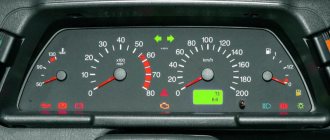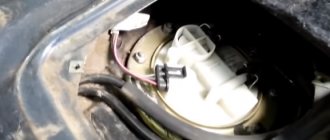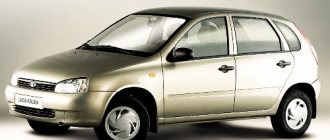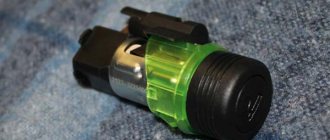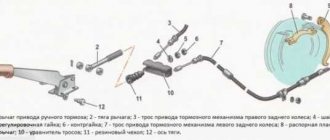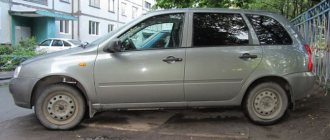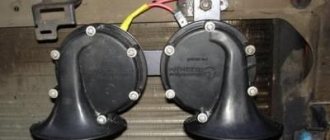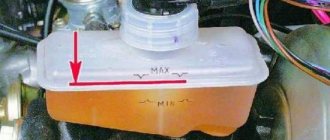In 1995, the Volzhsky Automobile Plant began production of a car, at that time a new generation VAZ-2110 with a sedan body.
Immediately, two more cars were produced on the basis of this model, with a station wagon body - VAZ 2111 and a hatchback - 2112.
Production of all three models continued until 2007.
The 10-series models belonged to the budget category of cars, which naturally affected the quality of materials and the car’s assembly itself, but in general, despite the questionable build quality, the car turned out to be in demand.
Historically, VAZ cars have never been famous for their reliability; this trend has not bypassed the 10th family either.
But it is worth noting that the maintainability of these machines is quite high; many problems are completely fixable, even in garage conditions. And the cost of spare parts is significantly lower than for foreign analogues.
Like any car, the VAZ-2110 and models based on it have weak points that you should first pay attention to during operation.
Next, we will go through all the components of the VAZ-2110, 2111, 2112 cars, with which problems most often arise, and at the end we will dwell on the reviews.
The injector is
Before we look at the signs of a faulty VAZ 2110 injector , let's understand what it is. In simple words, the type of injection into the cylinders. A couple of decades ago, it replaced the carburetor. Since the principle ensures maximum combustion. Due to careful dosing of gasoline and air. And also mixing with each other. Therefore, it is difficult to achieve this by spraying the carburetor.
So, let's understand this structure. Firstly, the electronic control unit (ECU) is located in the cabin, at the feet between the driver and passenger. The ECU is the heart of the unit. Since it controls the entire structure. That is, it regulates the supply of the combustible mixture. And also informing about problems with the “ check engine ” indicator.
Next is the fuel pump, which is located in the gas tank. From it, gasoline flows through the main line through the filter into the ramp. What is located directly on the motor. As a result, there are injectors on the ramp. Which spray gasoline, mixing it with air into the cylinders.
Interior and body
High-quality assembly of a car interior is clearly not about the VAZ-2110. Rattling, “crickets” and squeaks in the interior of this car are present from the factory. The owners either put up with this or begin a complete overhaul of the interior.
Another disadvantage in the cabin is the heating and ventilation system. The interior heater very often stops performing its functions.
And finally – the body.
Among the main problems with the body, we can note the weak anti-corrosion treatment of the bottom, as well as the lack of plugs in technological holes, which is why corrosion often forms in these holes.
Additionally, corrosion may appear near the windshield seals. This applies to all models of the 10th family.
As for models 2111 and 2112, they have more problems with the body than the sedan.
The rear door of these models often rattles a lot. Crickets in the trunk are common. Corrosion on the tailgate appears very often.
On a VAZ-2111, when closing the rear door, the reflector may be destroyed. Also, the paint on the roof rails of this model quickly flies off, especially on the A-pillars.
Injectors
Nozzles or “injector” are the main part of the body. It is a solenoid valve and atomizer, it is activated by a signal. Hence, which comes from the block. First of all, collecting information from meters. Due to this, a combustible mixture is created, but due to the poor quality of gasoline, the nozzle often fails. That is, it gets clogged with dirt.
If it fails, the operation of the machine becomes incorrect. That is, there are jerks and dips when starting and moving, detonation, difficult starting and a decrease in dynamics. Therefore, cleaning the nozzle is the first priority in repairs. And due attention must be paid to this process.
Firstly, the easiest way to clean it is to pour liquid into the tank and mix it with gasoline. Secondly, you need to remove the fuel rail. I would like to draw your attention to the fact that on 8 valve engines the ramp is located in the rear of the engine, but on 16 valve engines it is in the front. When removing the ramp, you will have to dismantle the air manifold. Because he just gets in the way. Then disconnect the injectors from the ramp. Next, apply 12 volts to the nozzle to open the valve and blow it out with a cleaning spray.
Engine
- All main sensors are more or less reliable, but the mass air flow sensor and IAC require periodic cleaning of crankcase gases (they are subject to heavy contamination).
- When approaching 60 thousand mileage, it is imperative to replace the timing belt, otherwise the likelihood of a break is very high.
It is worth noting that there are a number of additional problems with the engine related to cars produced in 2002–2003, which are missed in this case.
Signs of a malfunctioning VAZ 2110 injector
Signs of a malfunction of the VAZ 2110 primarily manifest themselves in incorrect operation. But despite the fact that the LADA is a car. Unfortunately, there are problems that are quite difficult to determine without computer diagnostics. But we'll talk about this later. Below are examples of shortcomings in the operation of the car:
- check engine on the dashboard also came on
- The engine is not running stable;
- Power is noticeably reduced;
- Increased gasoline consumption;
- Difficult to launch or not possible at all.
Signs of a malfunction of the VAZ 2110 injector. The “check engine” indicator also lights up
The “ check engine ” indicator on the dashboard came on. The most common problem, but unfortunately it is not always associated with a breakdown. Because we must not forget that this is an AvtoVAZ and anything can be in it. Firstly, it may be a simple glitch in the program that does not affect operation. I have had moments when the indicator would light up and go out after a while. At first, I went to the service in a panic, but no errors were found. Because everything worked properly.
But if, in addition to the “ check engine ” indicator on the dashboard, you feel obvious deviations. You will have to do diagnostics to identify the cause of the breakdown, but even here there can be a catch. Since most experts do not recommend getting into the structure yourself, due to its complexity. But they cannot identify the problem themselves. For example, a situation where more than one service station could not find the cause. Referring to defective parts. Which I changed twice a day, buying a new one. And only one guy in the garages found a broken wiring. Which no one paid attention to.
Chassis and transmission
The chassis of the 10th family did not show its best side. Problems with it arise after about 40 thousand km. Shock absorbers on a car, approaching this mileage mark, are already beginning to fail. Moreover, they don’t just sag, they begin to flow.
The next chassis elements that require replacement at 40 thousand km are ball joints. Next to the bearings, the hub bearings will require replacement.
After replacing the shock absorbers, supports and bearings, you should not relax; a little later, at about 55 thousand km, the external constant velocity joints - CV joints - will begin to make themselves felt and require replacement.
The main element of the transmission, the gearbox, as a whole, did not cause significant problems. However, such a nuisance often arose as the difficulty of engaging second gear.
Not everything is in order with the gearbox control drive either; the weak link of the drive was the plastic bushing of the rocker. Well, in general, the owners note a slightly increased noise level of the box.
The brake system, in addition to replacing consumables, often “pleased” with the weakening of the handbrake cable tension, but otherwise there were no serious problems with this system.
For other common faults of the VAZ 2110, see the photo below.
Diagnostics of the VAZ 2110 injector
In this section I will tell you several diagnostic methods. Since there are cases when the “ check engine ” indicator on the dashboard does not light up. And there are no significant deviations in the car. But diagnostics can reveal the problem. So, let's begin.
Computer diagnostics
Computer diagnostics are carried out in two ways. First, contact a service station. Where specialists see the full characteristics and errors through a computer. They will point out the problematic part and usually send you to change it. But as I said earlier , this does not always help. Since the specialist sees only the electrical sensor from which there is no signal. But the problem may also be in the wiring, and you go to auto parts and spend money.
Secondly, using the phone. To do this, you need to purchase a wireless adapter for diagnostics and install applications on your phone. Then connect the adapter to the diagnostic connector. The one that is located in the cabin, near the driver’s feet. Next, turn on Bluetooth on the phone and connect to the device. Let's start scanning for errors. If there are problems in the brain, a code will be displayed on the phone. You can decipher it on kodobd.ru
Also, using the adapter , you can view measurements in real time. That is, revolutions, consumption and data from electrical sensors. In general, a very useful thing, you only pay for services once. When you purchase an adapter.
Self-diagnosis
Self-diagnosis is carried out using the on-board computer. One way is if there is a side panel on the center console, then you are very lucky. I had one of these on one of my cars. In general, there are no problems, it is very easy to check errors at any time. We go to the menu and use the “left” or “right” buttons to find the “diagnostics” section. Then use the “down” button to go in and look for “errors” in the same way. We are shown errors in the form of code . By holding down the down button, the error code will be cleared.
The second method of self-diagnosis, unlike the first, can be performed on every ten. This is done using a device. You do not need any special equipment to perform the procedure. Just with the ignition off, press and hold the “reset daily mileage” button on the dashboard. And at the same time turn the key to the first position, turning on the ignition. As a result, all the lights will light up. And also all the arrows will begin to move, from start to finish and back. Then we press the “reset daily mileage” button again, the brain firmware version appears on the display. Then press one more time and we see the error code . But in this case, the code will not be the usual “P0135”, but one or two digits.
Owner reviews
But if we take it as a whole, this family of VAZs performed well. Of course, many characterize the VAZ-2110, 2111, 2112 cars only on the negative side, but there are also enough car owners who like these cars.
What's positive.
One of these owners points to the good torquey engine, which makes it feel good when overtaking and maneuvering.
The second car owner points out that with the right approach, cars of this family are very reliable, you just need to take care of them.
The third likes that the fuel consumption of the VAZ-2110 is not that high, and this car is not particularly sensitive to fuel quality.
And the fourth car owner likes the fact that the cost of maintaining a car is low, and spare parts are very easy to get.
Negative reviews.
Opponents of this car also have enough arguments.
The first one does not like the poor corrosion resistance of the body, especially near the windshield seal.
The second owner notes that although the spare parts are cheap, the car breaks down much more often than foreign models in this price range. And there is a high probability of purchasing non-original parts that last much less.
Read on the topic: How to buy spare parts correctly.
The third indicates eternal problems with interior heating, and what causes the most inconvenience in this matter is not the occurrence of the malfunction itself, but the difficulty of eliminating it.
And the fourth notes the overall poor reliability of the car, so the VAZ-2110 constantly requires investment.
VAZ 2110 sensors
In this section I will provide an overview of the electrical sensors that are installed on injection engines. As well as their location and the cause of failure.
Mass air flow sensor (MAF)
The air flow sensor is one of the most vital organs. It is located in a visible place, right behind the air filter.
Measures the amount of air entering the cylinders. And transmits readings to calculate the required amount of gasoline. Quite reliable and rarely fails, but over the years it can begin to produce information that is not entirely correct. In this case, the engine begins to work unstably, but the “ check engine ” indicator does not light up. Since the part works and the signal is received, the car may behave differently:
- Difficulty starting;
- Floating idle speed;
- Jerks and dips when starting and moving;
- Increased consumption;
- Decrease in dynamics.
Crankshaft position sensor (CPS)
DPKV is also vital. Installed at the bottom of the engine on the oil filter side. On the generator drive gear.
Reads the crankshaft torque and provides information to the unit. He, in turn, sees that the shaft rotates and regulates the fuel supply. It is quite reliable and rarely fails, but due to its location it often gets clogged with dirt. That is, it stops responding to movements. But it is very easy to treat; we dismantle it and clean it of dirt. Signs of malfunction:
- The engine stalls during operation;
- The engine does not start at all.
Oxygen sensor (OS)
DC or as it is also called “lambda probe”. Installed in the exhaust manifold. That is, it serves to measure the level of exhaust gases. Thanks to it, the ECU controls the dosage of gasoline and air. In other words, without increasing gas pollution. Since it sometimes becomes covered with soot, it may give incorrect readings. In this case, it is necessary to dismantle and clean with phosphoric acid. Signs of malfunction:
- Decrease in dynamics;
- Increased consumption;
- Black smoke from the exhaust pipe;
- Floating speed when warming up.
Idle speed sensor (IAC)
The DXH is mounted on the rear of the throttle body. Consequently, it regulates the air supply at idle speed. That is, when you press the accelerator pedal, the DHW is turned off. It also has the ability to become clogged and fail. I've heard from many people that it can be cleaned, but I've never done it myself. Since its price is not very high. It seems easier to me to replace it with a new one. Signs of malfunction:
- Floating idle speed;
- Difficulty starting;
- The engine stalls when idling.
Throttle Position Sensor (TPS)
The TPS is installed on the rear of the throttle valve, next to the DHX. It transmits information about the position of the throttle valve, as it is directly connected to the accelerator pedal. That is, pressing the accelerator pedal opens the air supply. Meanwhile, the ECU sends a signal to supply fuel. Unfortunately, the TPS very often fails and requires replacement with a new one. Because it cannot be repaired. Signs of malfunction:
- The speed increases randomly;
- Difficulty starting;
- Increased consumption.
Coolant temperature sensor (DTOZH)
The DTOZH is installed on the thermostat in the area of the air filter, under the mass air flow sensor. Firstly, it is responsible for cold starts. That is, it sends a signal about the state of heating of the coolant to the ECU, which in turn regulates the fuel supply. Secondly, it controls the temperature, preventing the motor from overheating. Because the signal turns on the cooling fan. Signs of malfunction:
- Increased consumption;
- Difficulty starting;
- Floating speed when warming up.
Speed sensor (DS)
The DS is installed on the rear side of the engine in the throttle valve area, at the bottom, at the gearbox. It is responsible for speed, that is, it sends a signal to the instrument panel. Signs of malfunction:
- Speedometer malfunction.
Phase sensor (PF)
The DF is installed in the front part of the engine, in the timing belt area above the generator. Since it is responsible for the camshaft speed. That is, if the timing belt breaks, the fuel supply is stopped by the DF signal. If it fails, the system goes into emergency mode. Signs of malfunction:
- Increased consumption;
- Decrease in dynamics;
- Floating idle speed.
Knock sensor (DS)
The DD is installed in the front part of the engine on the block, between the second and third cylinders. Designed to control detonation. That is, the ECU receives a signal and doses the combustible mixture, thereby reducing detonation. Signs of malfunction:
- Decrease in dynamics;
- Floating idle speed;
- Jerks and dips when starting and moving.
Engine chip tuning circuit
Not many car enthusiasts can boast of a powerful 2110 engine. Thus, to improve the power characteristics of the engine, it is necessary to carry out chip tuning of the VAZ 2110. To do this, they usually turn to specialists, but more and more vehicle owners are doing the process themselves.
The chip tuning scheme is quite simple. To perform the operation yourself, you will need an OBD II cable (USB-Auto), a laptop computer and software. It is worth remembering that there are three options for modifying the power unit: for power (but this will increase consumption), for reducing consumption (leading to a loss of power) and balanced (balance between the optimal indicators of consumption and power).
Typically, chip tuning of a VAZ 2110 is done with the aim of reducing fuel consumption, therefore, if the owner of the car decides to do it himself, then it is necessary to select the appropriate software. But, it is recommended not to take risks and turn to professionals for help.
